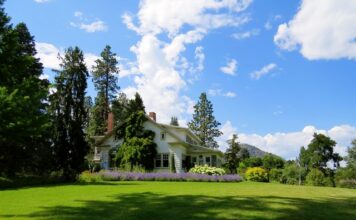In this comprehensive guide to vertical gardening, readers will learn about the history and benefits of this space-saving technique. The article delves into various types of vertical gardens, including green walls, trellises, hydroponic systems, and more. It also provides advice on choosing the right garden for your space, considering factors such as indoor vs. outdoor, space requirements, and structural considerations. Readers will also discover tips on designing, building and maintaining their vertical garden, including selecting the right plants, irrigation, and pest management. Additionally, the article highlights the environmental impact and sustainability aspects of vertical gardening, as well as providing inspirational examples and case studies from successful residential, commercial, and urban farming projects.
What is Vertical Gardening?
Definition and Concept
Vertical gardening is an innovative and space-saving approach to agriculture that involves growing plants on vertical surfaces, such as walls, fences, or structures specifically designed for that purpose. This technique allows plants to be grown in a relatively small space, making it an ideal solution for urban environments, indoor spaces, and small landscapes. Vertical gardening can be accomplished through various methods such as trellising, using hydroponic systems, or attaching specialized containers onto walls or other supporting structures.
The basic concept of a vertical garden is to create a visually appealing, space-saving, and efficient growing environment. This is achieved by incorporating different techniques which enable the plants’ roots to reach the nutrients they require to grow. Vertical gardens can be populated with a variety of plant types, from decorative flowers to edible herbs, fruits, and vegetables. They can also be customized to fit any type of space, depending on the needs, preferences, and resources of the gardener.
History of Vertical Gardening
The practice of vertical gardening is not a new concept. It can be traced back to ancient civilizations such as the Mesopotamians, Egyptians, and the hanging gardens of Babylon, one of the Seven Wonders of the Ancient World. These ancient gardeners created their vertical gardens by stacking rocks or other materials, providing them with the necessary support to grow plants.
Throughout history, vertical gardening techniques have evolved alongside improvements in technology and urbanization. In the 19th century, the use of vertical gardens, known as “green walls,” was popularized by architect and horticulturist Dr. Patrick Blanc. He is credited with inventing the modern concept of vertical gardens or living walls by integrating plant support structures, irrigation systems, and substrate materials into the walls of buildings.
In recent years, vertical gardening has gained recognition as an eco-friendly approach to agriculture and is being increasingly explored as a means to improve air quality, reduce carbon emissions, and encourage sustainable urban development. The growing awareness surrounding vertical gardening has led to numerous research studies and innovations, increasing the viability and appeal of vertical gardening as a practical and attractive solution in various environments.
Benefits of Vertical Gardening
Vertical gardening offers several benefits that make it an appealing option for both novices and experienced gardeners. Some of these benefits are:
- Space-saving: Vertical gardening is ideal for small spaces, especially in urban environments, balconies, or indoor spaces. By growing plants vertically, gardeners can maximize limited space and even contribute to the greening of cities.
- Better pest and disease control: Growing plants vertically reduces the risk of soilborne diseases and pests. This position allows for better circulation and makes it harder for pests to reach the plants, improving overall plant health.
- Increased yields: Vertical gardening techniques can result in higher yields per square foot, as plants are allowed to grow in a larger area than traditional horizontal gardens.
- Improved accessibility: Vertical gardens make it easier for gardeners to care for and harvest their plants, making gardening more accessible for people with limited mobility or disabilities.
- Enhanced aesthetics: Vertical gardens add visual interest and beauty to various environments, from private residences to public spaces.
- Environmental benefits: Vertical gardens make use of underutilized spaces, help reduce heat island effects in cities, promote biodiversity, and can even improve air quality through the process of photosynthesis.
Overall, vertical gardening is a versatile, sustainable, and attractive solution that offers a myriad of benefits to individuals, communities, and the environment. It is a practice that continues to grow in popularity as both a functional and creative gardening approach.
Types of Vertical Gardens
Vertical gardens are an innovative and sustainable method of incorporating greenery into urban environments, whether it’s for aesthetic or functional purposes. They can be created as a freestanding structure, built onto walls, or hung from ceilings. Here are various types of vertical gardens, each with their distinct advantages and applications.
Green Walls/Living Walls
Green walls, also known as living walls, are the most prevalent type of vertical gardens. They are usually attached to an existing wall or a freestanding structure. Green walls are made up of vegetation that grows on specially designed support structures. The support structure contains a soil substitute, such as coconut fiber or felt, to allow plant roots to anchor and grow while promoting proper water and nutrient distribution. Living walls offer multiple benefits such as improved air quality, reduced noise pollution, and enhanced aesthetics.
Vertical Planter Systems
Vertical planter systems can be wall-mounted or freestanding, and they provide an excellent option for those wanting to grow herbs, vegetables, or flowers in a space-saving manner. These systems often use trays or containers with vegetation placed in columns or rows. The plants can be easily accessed for maintenance and harvesting, making them popular among urban gardeners. Vertical planter systems may also include an irrigation system to provide water and nutrients to each plant as necessary.
Trellises and Climbing Gardens
Trellises provide support for plants that naturally climb, such as ivy or vines, allowing them to grow vertically as they follow the structure’s design. Climbing gardens are an ideal way of utilizing a small outdoor space while creating a visual and functional barrier. A trellis can be affixed to walls, fences, or used as a standalone feature. It can be made from various materials like wood, bamboo, or metal lattice. The trellis’s sturdiness is essential to support the plant as it grows and requires regular maintenance to ensure the plant’s proper growth.
Hydroponic Systems
Hydroponic gardening is a soilless method of growing plants using nutrient-rich water. This advanced technique allows for a more space-efficient system that can be implemented vertically. In hydroponic vertical gardens, plants absorb nutrients from the water directly by suspending their roots in the nutrient-rich solution. Hydroponic systems often require less water and have fewer pests and diseases compared to soil-based systems. They also may promote faster plant growth and higher yields.
Hanging Gardens
Hanging gardens are perhaps the easiest to implement and maintain; they involve suspending plant containers or pots from walls, ceilings, or other structures. This type of vertical garden is ideal for small areas and can be used to add a decorative touch to balconies, patios, or interiors. The plants can be swapped out seasonally or as desired, making it a flexible option for gardeners. Hanging gardens work best with plants that have a trailing or cascading growth habit, such as ferns or ivy.
Stacked Gardens
Stacked gardens utilize layered containers or shelves to maximize space and create a cascading effect. These gardens can be built using various materials, including wood, metal, or recycled materials like shipping pallets. Stacked gardens can be used to display a variety of plants, including herbs, flowers, and even small shrubs. Ensure that each level receives sufficient sunlight, water, and airflow to promote healthy plant growth.
Recycled Material Gardens
For the environmentally conscious gardener, creating a vertical garden using recycled materials can be both sustainable and visually appealing. Common recycled materials like plastic bottles, old gutters, wooden pallets, or reclaimed containers can be repurposed into functional and artistic garden spaces. These gardens can be designed to meet individual needs and preferences while minimizing environmental impact. Recycled material gardens can be easily adapted and expanded, allowing for endless possibilities in vertical gardening.
Choosing the Right Vertical Garden for Your Space
Vertical gardens offer a unique and space-saving method for cultivating plants in your home, office, or yard. However, choosing the right vertical garden for your available space can be a challenge. To help you navigate this decision, below are essential factors to consider, including indoor vs. outdoor gardens, space requirements, structural considerations, cost, and climate and lighting needs.
Indoor vs. Outdoor
The first factor to consider is whether you want to build a vertical garden indoors or outdoors. Indoor vertical gardens can make an attractive addition to your living space, purify the air, and provide you with a source of fresh produce (depending on the plants you grow). Indoor gardens may require specialized equipment, such as grow lights, and you’ll need to take extra care with drainage to avoid water damage to your interior space. Popular indoor vertical garden designs include living walls, shelves or racks, and hydroponic systems.
Outdoor vertical gardens can be larger and may involve a wider variety of plants. When planning an outdoor garden, you need to consider the climate, sunlight, and wind exposure. Outdoor gardens typically include more hardy plants and can incorporate existing landscape features, such as trellises, fences, and walls. Outdoor gardens generally require more water and maintenance, primarily due to exposure to outside elements.
Assessing Space Requirements
Determine the area you have available for your vertical garden. Consider the height, width, and depth of any installations or structures needed to support the garden. You should also account for any additional space required for proper air circulation and plant growth. To make the most of your space, consider the mature size of the plants you’ll grow, choosing smaller or dwarf varieties for confined areas.
When selecting your garden location, consider the room you have for installation and maintenance. For example, factor in the need for a ladder or scaffolding during installation or ongoing maintenance. Ensure you can easily access any irrigation or watering systems.
Structural Considerations
Vertical gardens can range from a few hanging pots on a wall to intricate hydroponic installations. Evaluate the supporting structure needed for your garden, considering the weight of the plants, soil, and water. Confirm if the current structural elements of your space, such as walls or fences, can withstand the additional weight or if you require new support structures.
For outdoor gardens, ensure any support structures can handle weather exposure, and opt for materials like treated metals, galvanized steel or weather-resistant wood. For indoor gardens, sound and waterproof construction is imperative to protect your home.
Cost Analysis
Budget is a significant factor influencing your vertical garden choice. Determine if you want to invest in a permanent installation or a temporary, modular system. Permanent gardens, like living walls or complex hydroponic systems, can be more costly upfront but offer long-lasting benefits. Modular gardens, such as shelving units or pocket gardens, are more affordable and adaptable to your space and needs.
Factor in the cost of plants, soil or growing medium, irrigation systems, and lighting. Regular maintenance costs, such as fertilizer, pest prevention, and water, should be considered as well. Building a vertical garden may be an investment but can offer rewards, like increased property value and aesthetics.
Climate and Lighting Considerations
Successful plant growth is highly dependent on climate and light conditions. Evaluate the sunlight and temperature of your garden space, both current and seasonal, and choose plants accordingly. Some plants require full sun, while others thrive in shade or with indirect light. Select plants suitable for your local climate and place them in groups with similar requirements within your garden.
For indoor gardens, you might need to invest in artificial lighting or grow lights, especially if your interior space lacks natural light. Ensure the lights you choose provide sufficient light intensity and the correct spectrum of colors your selected plants require.
In conclusion, choosing the right vertical garden for your space can be a rewarding endeavor, offering beauty, increased property value, and health benefits. Taking the time to thoroughly evaluate your garden space, budget, and other factors can help ensure your vertical garden is a success.
Designing and Building a Vertical Garden
Design Principles and Aesthetics
Designing a vertical garden involves much more than just the selection of plants. It is crucial to first understand the design principles and aesthetics, as these factors will significantly influence your vertical garden’s success and overall appearance. The basis of a good design includes the following considerations:
- Location: Identify the desired location of your vertical garden by assessing existing conditions, such as light exposure, proximity to water, and the general surroundings. The location should be easily accessible for maintenance, have adequate sunlight (at least four hours for most plants), and be sheltered from harsh elements.
- Functionality: Determine the purpose of your vertical garden. Some common functions include privacy screens, space dividers, food production, art installations, and therapeutic gardens. This will influence your choice of plants and other design elements.
- Space utilization: Vertical gardens can be designed for small or large areas. Consider the space available and appropriate sizes for each type of plant’s growth. Ensure each plant has enough space to grow without overcrowding or competing with its neighbors.
- Visual appeal: Select plants that have a strong visual impact on the viewer. Consider your preferred colors, textures, and patterns. A visually appealing garden can be created through the use of focal point plants meticulously arranged among smaller plants in the design.
- Cohesion: Design the layout of the vertical garden by using repetition, harmony, balance, and contrast. These design principles add interest, help the viewer move through space, and create a visually cohesive environment.
- Sustainability and maintenance: Choose plants that are easy to maintain and have low environmental impacts, such as drought-tolerant or native species. Ensure that your design will accommodate any future maintenance needs.
Planning and Sketching
Once you have considered the design principles and aesthetics, it is essential to create a plan and sketch your vertical garden. Begin by taking measurements and photos of your chosen location, considering any existing structures, soil, and drainage.
Draw a scaled plan of the area, outlining the existing elements and location of the vertical garden. Mark the dimensions clearly and any possible constraints, like walls or pathways.
Next, begin to sketch your vertical garden, considering the plant selection and design principles. Show the plant arrangement and detailed layout for your vertical garden, using different colors or symbols to represent different plant types. Remember to take into account the growth habits, light requirements, and maintenance needs of each plant.
Choosing Materials
When selecting materials for your vertical garden, consider the following factors:
- Durability: Choose materials that can support the weight of plants, soil, and water without breaking or sagging under heavy loads. Examples of durable materials include treated wood, metal, and plastic.
- Weather resistance: Opt for materials that are resistant to weathering, rust, and rot. This will ensure that your vertical garden remains in good condition for a longer time.
- Sustainability: Choose eco-friendly materials that have low environmental impacts.
- Aesthetics: Ensure that the materials are visually appealing and complement your overall garden design.
Some popular materials used for vertical gardens include:
- Wood: Treated wood can be used for constructing garden frames and supports.
- Metal: Aluminum or galvanized steel can provide sturdy support for planters and other vertical garden elements.
- Plastic: Recycled plastic or PVC pipe can be used to build planters or support structures.
Construction Tips and Techniques
Constructing a vertical garden requires careful planning, attention to detail, and proper use of materials, tools, and techniques. Here are some tips and techniques to follow while building your vertical garden:
- Start with a stable, level foundation: Your vertical garden must be built on a stable and level base to ensure proper drainage and plant growth. Use a spirit level to check the base and make any necessary adjustments.
- Consider drainage and watering requirements: Proper drainage is crucial to prevent waterlogging and maintain healthy plant growth. Include drainage holes or pipes in your design and ensure that they are appropriately connected to external drainage systems. Consider installing an automated watering system, especially for larger vertical gardens or if located in areas with limited water access.
- Assemble materials and tools: Gather all the necessary materials and tools in advance, making sure you have everything you need to complete the project.
- Build planters and support structures: Construct sturdy planters and support structures according to your design, using recommended materials and techniques. Ensure that the structures are secured and supported adequately to prevent any accidents or damages.
- Add soil and plants: Fill the planters with a suitable growing medium, such as potting mix, and plant your selected plants as per your design.
- Monitor and maintain: Regularly inspect your vertical garden for signs of problems or wear and tear, and carry out necessary maintenance and repairs when needed.
By following these design, planning, and construction guidelines, you’ll be well on your way to creating a successful and visually stunning vertical garden that will enhance your living space and boost your well-being.
Selecting Plants for Your Vertical Garden
Vertical gardens are an innovative gardening technique that is suitable for people with limited ground space or those who want to make use of their walls for aesthetic and functional purposes. Selecting the appropriate plant species is a crucial step in creating a successful and thriving vertical garden. In this section, we will discuss various factors to consider when choosing plants for your vertical garden, such as types of plants, size and growth pattern, climate-specific selections, and beneficial plant combinations.
Edibles vs. Ornamentals
The first step in selecting plants for your vertical garden is deciding whether you want to grow edibles or ornamentals. Edibles include fruits, vegetables, and herbs, while ornamentals typically comprise of flowering and foliage plants. Some people may prefer a combination of both, while others may lean more towards one type.
Edible plants can be ideal for small urban spaces, as they provide fresh produce and help to reduce grocery bills. Some popular edible plants for vertical gardens include strawberries, tomatoes, peppers, lettuce, spinach, and various types of herbs such as basil, mint, and parsley. The key to a successful edible vertical garden is choosing plant varieties that have shallow root systems, compact growth habits, and don’t require a lot of space to grow.
Ornamental plants, on the other hand, provide visual appeal and can greatly enhance the aesthetics of your vertical garden. When choosing ornamental plants, consider varieties with attractive foliage, colorful flowers, and interesting textures. Excellent options for ornamentals include ferns, bromeliads, philodendrons, begonias, and various types of succulents.
Choosing Plants Based on Size and Growth Pattern
Another important factor to consider when selecting plants for your vertical garden is their size and growth pattern. Larger plants may require more extensive support systems to ensure that they are properly secured, while smaller plants may grow quickly and fill in gaps between plantings more efficiently. When assessing potential plants, consider their mature size, growth rate, and how they will be secured in the vertical garden structure.
Creeping or trailing plants are particularly well-suited for vertical gardens, as they can easily spread and cover the surface of the structure. Examples of this type of plant include ivy, creeping thyme, and various types of ground covers. In contrast, plants with upright or bushy growth habits, such as ornamental grasses and dwarf shrubs, may require more support and maintenance to remain visually appealing and healthy.
Climate-specific Plant Selections
It’s essential to select plants that are appropriate for your specific climate and microclimate to ensure a successful vertical garden. Research the hardiness zones and recommended growing conditions for each plant you are considering, and choose plants that are suited for your region. Keep in mind that the microclimate near your wall might differ from the ambient conditions, which can affect factors such as sun exposure, temperature, and humidity levels.
If you live in an area with hot and sunny conditions, consider heat-tolerant and drought-resistant plants such as succulents, cacti, and Mediterranean herbs. In contrast, plants that prefer cooler and moister conditions, such as ferns and some varieties of perennial flowers, thrive in shadier environments and would be a better choice for vertical gardens in cooler regions.
Beneficial Plant Combinations
When choosing plants for your vertical garden, it is beneficial to consider how the different varieties will interact with one another. Some plants demonstrate synergistic relationships, which means they grow better and perform more effectively when planted in close proximity. This concept is called companion planting.
Examples of beneficial plant combinations include the traditional “Three Sisters” planting method, which involves corn, beans, and squash grown together in a mutually beneficial arrangement. The corn provides support for the beans, the beans fix nitrogen in the soil to improve its fertility, and the squash leaves create a natural mulch that helps retain moisture and deter weeds.
Another example is planting marigolds or nasturtiums with tomatoes, as these flowers emit a strong scent that repels harmful insects and lures predators of pests. This creates a healthier, more productive environment for the tomatoes.
In summary, carefully selecting plants for your vertical garden that suit your preferences, growth patterns, climate, and companion planting can result in a healthy and visually appealing vertical garden. Conduct research on potential plant choices and experiment with different combinations to discover what works best for your space and needs.
Maintaining and Caring for Your Vertical Garden
Vertical gardens are an innovative and space-saving way to grow plants in urban environments or smaller areas. These gardens not only improve air quality but also give a fresh, natural touch to the ambiance, enhancing mental well-being. However, maintaining and caring for a vertical garden require constant attention and a set of specific procedures. This article will discuss essential aspects of vertical garden maintenance, such as irrigation and water management, soil and nutrients, pruning and training plants, and pest and disease management.
Irrigation and Water Management
Proper irrigation is critical for a healthy and thriving vertical garden. Water is not only essential for the plant’s growth, but it also helps to distribute nutrients through the system. Typically, vertical garden systems use drip irrigation, which helps conserve water by supplying it directly to the plant roots. The following points outline the best practices for irrigation and water management in vertical gardens:
- Install an efficient drip irrigation system to ensure each plant receives an adequate water supply.
- Install a timer to automate the watering process and ensure plants receive water at the appropriate duration and intervals.
- Monitor and regularly check the irrigation system to prevent leaks, blockages, and other issues that can compromise plant growth.
- Water the plants according to their specific needs, considering the climate, season, and plant species.
- Regularly recycle or replace the water in the system to maintain its cleanliness and prevent the accumulation of harmful algae or bacteria.
Soil, Nutrients, and Fertilization
The soil in a vertical garden must always be nutrient-rich and well-aerated, as plant roots need sufficient oxygen to function. The following are essential factors to consider regarding soil, nutrients, and fertilization in a vertical garden:
- Use high-quality soil, preferably with good drainage properties, such as a mix of peat, perlite, and vermiculite.
- Add slow-release fertilizer to the soil to ensure that plants receive nutrients consistently over an extended period.
- Implement a regular fertilization schedule based on the specific needs of the plants in your garden. Organic fertilizers, such as compost tea or worm castings, can be great additions.
- Monitor the nutrient levels in the soil and adjust the fertilization schedule if particular deficiencies or imbalances are detected.
- Ensure proper aeration in the soil by occasionally turning and mixing it.
Pruning and Training Plants
Regular pruning and plant training are essential for maintaining the structure, health, and appearance of a vertical garden. This process ensures adequate light and air circulation reaches all plants, prevents overgrowth, and may even encourage flowering or fruiting. Keep the following aspects in mind when pruning and training your vertical garden:
- Regularly trim and remove dead or yellow leaves, as well as excessive growth, to maintain a clean appearance and promote plant health.
- Train plants to grow in the desired direction by gently securing them to the support structure with ties or clips.
- Monitor growing plants for signs of overcrowding and adjust their positioning to ensure proper light and air access.
- Use sharp, sterilized tools when pruning and disinfect them between cuts to prevent the spread of disease.
Pest and Disease Management
Pest and disease management is crucial for maintaining a healthy vertical garden. The following are steps to consider for effectively managing pests and diseases in your vertical garden:
- Regularly inspect plants for signs of pests and diseases, such as insect infestations, fungal infections, or physical damage.
- Implement integrated pest management strategies, which involve using various complementary methods such as biological control, physical barriers, and selective chemical control.
- Encourage beneficial insects by adding plants that attract them, such as ladybugs, hoverflies, and lacewings, which help control harmful pests.
- Use least-toxic pesticide alternatives or homemade remedies, such as neem oil or insecticidal soap to reduce potential risks to beneficial insects and the environment.
- Remove and properly discard infected plants and debris to prevent the spread of diseases.
By diligently following these guidelines on irrigation, soil management, pruning, and pest control, you can ensure that your vertical garden remains vibrant, healthy, and aesthetically pleasing for years to come.
Sustainability and Environmental Impact
Sustainable development has gained significant momentum in recent years, driven by the need to reduce the human impact on Earth’s ecosystems and resources. Sustainability primarily pertains to the development and implementation of practices that protect the natural environment from degradation while using resources wisely. Green roofs facilitate resource conservation, urban heat island mitigation, air purification, habitat creation, and food production, thus contributing to enhanced sustainability and reduced environmental impact.
Resource Conservation
Green roofs are instrumental in conserving resources, as they offer better thermal insulation for buildings, resulting in lower energy consumption and reduced dependence on non-renewable energy sources. The temperature-regulating properties of green roof systems significantly decrease the need for air conditioning in warmer months and reduce heat loss during cold periods. Consequently, the demand for energy to maintain comfortable indoor temperatures is minimized, and energy consumption is optimized.
In addition to conserving energy, green roofs help manage water resources more efficiently. They retain, filter, and attenuate stormwater runoff with the capacity to capture 60-100% of precipitation, depending on the design and depth of their layers. This reduces the volume of stormwater discharged into sewer systems, decreases the risk of flash floods, and mitigates the impact of combined sewer overflows on the environment. Green roofs also act as natural filters, removing particulate matter and pollutants from stormwater runoff, thus improving its quality.
Urban Heat Island Mitigation
Urban heat islands, a phenomenon where densely built-up areas have considerably higher temperatures than their surroundings, are prevalent worldwide, particularly in cities with extensive paved surfaces and a dearth of green space. These heat islands exacerbate energy consumption, air pollution, and greenhouse gas emissions, and they undermine human comfort and health.
Green roofs are effective in mitigating the impact of urban heat islands by reducing surface and ambient air temperatures, releasing moisture into the atmosphere, and harnessing the natural cooling properties of evapotranspiration. These combined effects contribute to mitigating the urban heat island effect, thus promoting human well-being and decreasing the dependence on air conditioning systems.
Air Purification
Air pollution is another major environmental challenge that affects human health and ecosystems. Green roofs provide a natural solution for air purification by filtering particulate matter, gaseous pollutants, and other airborne contaminants through their vegetation, soil, and root system. Additionally, photosynthesis, the process by which plants produce energy, consumes carbon dioxide and releases oxygen, positively impacting air quality and mitigating the negative effects of greenhouse gases.
Habitat Creation
Rapid urbanization often results in urban sprawl, loss of natural habitats, and reduced biodiversity. Green roofs can act as havens for flora and fauna and serve as green corridors, linking fragmented habitats in urban areas. Vegetative cover enhances biodiversity by providing a habitat for various plant, bird, and insect species, developing ecological niches and fostering an integrated community of organisms. Green roofs can play a vital role in conserving endangered species and promoting urban ecology, thereby contributing to improved environmental sustainability.
Edible Gardens and Food Security
The potential to grow vegetables, herbs, and fruits on green roofs presents a viable solution to global food security challenges while bolstering sustainability. Urban agriculture on green roofs can increase access to fresh produce, reduce transportation-related emissions associated with importing food from rural areas, and add value to urban waste by utilizing compost from households as organic fertilizers.
Edible green roofs contribute to a more circular economy, as they reuse resources, minimize waste, and reduce reliance on conventional agricultural methods. They also educate city dwellers about the origin of their food by bringing agriculture closer to people and fostering a connection with nature in urban environments. Consequently, green roofs can play a critical role in enhancing environmental awareness, promoting healthy eating habits, and making cities more sustainable and resilient.
Case Studies and Inspirational Examples
Successful Residential Vertical Gardens
Vertical gardens, also known as living walls, are a popular design feature for residential spaces worldwide. By incorporating greenery into their homes, residents add not only beauty but also functionality, as these gardens improve air quality, provide natural insulation, and create a healthier living environment. Here are several successful residential vertical garden examples:
- Edouard François’ Flower Tower: This Paris-based architect incorporated vertical gardens into the exterior design of a residential building in 2004. The concept features large balconies with lush plants and flowers extending vertically along the building’s façade, creating a visually impressive and functional living space.
- Stefano Boeri’s Bosco Verticale: This residential building complex in Milan, Italy, known as the “Vertical Forest,” has made headlines worldwide for its innovative design. The development, completed in 2014, consists of two towers adorned with more than 20,000 plants, including trees, shrubs, and perennials, resulting in a striking green facade, reduced air pollution, and a unique living environment for its inhabitants.
- Greenery House by H&P Architects: This Vietnam-based architectural firm designed a home with multiple levels that incorporate living walls into the interior and exterior concepts. The result is a space with improved air quality, reduced temperatures, and harmonious balance between natural elements and contemporary design.
- Vo Trong Nghia’s Binh House: Located in Ho Chi Minh City, this multi-story residential project seamlessly integrates vertical gardens into the building’s façade, interior spaces, and rooftop terrace. The result is a stunning urban residence where greenery co-exists with modern architecture for comfortable, sustainable living.
Commercial and Public Spaces
Vertical gardens are also commonly found in commercial and public spaces, enhancing the visual appeal, improving air quality, and creating a sense of serenity for individuals within the space. Some remarkable examples include:
- Patrick Blanc’s Musée du quai Branly: Located along the banks of the River Seine in Paris, this cultural institution features an impressive 800-square-meter vertical garden along its exterior wall. Showcasing over 15,000 plants from 150 different species, it is a stunning testament to the visual and environmental impact vertical gardens can have.
- The CaixaForum Madrid: This cultural center in Spain is home to a 24-meter-tall vertical garden designed by Patrick Blanc, the pioneer of the vertical garden concept. Covering approximately 500 square meters, it features more than 250 plant species and serves as a symbol of the harmony between nature and architecture.
- The Singapore Changi Airport: The world-renowned Jewel Changi Airport showcases a breathtaking vertical garden and indoor waterfall at its core. The lush, multistory garden features a diverse array of tropical plants, creating an inviting and serene environment for travelers.
Urban Farming and Vertical Agriculture
Vertical gardens are not only decorative but can also play a vital role in urban agriculture. Combining innovative technologies with sustainable design principles, vertical farming is seen as a potential solution to global food security challenges. Notable projects include:
- Sky Greens: Located in Singapore, Sky Greens is the world’s first commercial vertical farm. The innovative farm uses a rotating structure that maximizes sunlight exposure and reduces water consumption. It produces fresh, locally grown vegetables for the city’s residents while showcasing the potential of vertical farms in crowded urban areas.
- AeroFarms: Based in Newark, New Jersey, AeroFarms utilizes aeroponic technology to grow leafy greens in a controlled, vertical farming environment. This approach uses 95% less water compared to traditional agriculture and allows for year-round production, solving some of the pressing issues faced by urban food systems.
Innovative and Unique Designs
Designers and architects continuously push the boundaries of vertical garden concepts, creating unique and innovative projects that inspire the world. Some standout examples include:
- The Tree House by ROI Studio: This design concept features a spiraling vertical garden wrapped around an urban tree, creating a tranquil oasis in the heart of the city.
- Green Cast by Kengo Kuma: This mixed-use building in Japan showcases an innovative façade design made from aluminum panels covered with creeping plants. The result is a unique, eye-catching exterior that adds greenery to the urban landscape.
- Vertical Garden House by Aamer Architects: This Singapore-based project elegantly integrates a vertical garden on the edge of the building, blurring the line between indoor and outdoor spaces while providing visual interest and functional benefits to the home’s residents.
1. What is the concept of Vertical Gardening?
Vertical Gardening is an innovative method of cultivating plants on a vertical surface or wall, typically through the use of planters, trellises, or modular gardening systems. This effective technique is ideal for urban dwellers, small spaces, or anyone seeking to maximize garden productivity.
2. How do Vertical Gardens benefit the environment?
Vertical Gardens contribute to reducing the urban heat island effect, improving air quality, and absorbing carbon dioxide. Additionally, cultivating plants in a vertical fashion helps conserve water through efficient irrigation systems and supports biodiversity within urban environments.
3. What types of plants are suitable for Vertical Gardening?
A majority of plants can adapt to Vertical Gardening, including herbs, vegetables, ornamental flowers, and even small fruiting plants. Choose species based on the wall’s location, climate, and available sunlight, ensuring appropriate support and maintenance for the plants.
4. Can Vertical Gardens be used as an alternative to traditional landscaping?
Yes, Vertical Gardens serve not only as an attractive, space-saving alternative but also an environmentally friendly option for those with limited space. Additionally, this method allows for easier access to the plants, simpler maintenance, and enhanced pest control.
5. Are there any special maintenance considerations for Vertical Gardens?
Regular maintenance for Vertical Gardens includes providing proper support structures, watering, fertilizing, pruning, and pest control. Consider using a drip irrigation system for efficient watering, and monitor closely for pests and diseases to ensure the garden remains healthy.
6. How does Vertical Gardening improve indoor spaces such as offices or homes?
Incorporating Vertical Gardens within indoor spaces contributes to a cleaner, healthier atmosphere by purifying the air and reducing noise pollution. The integration of greenery also promotes psychological well-being, provides a calming presence, and enhances overall aesthetic appeal.












